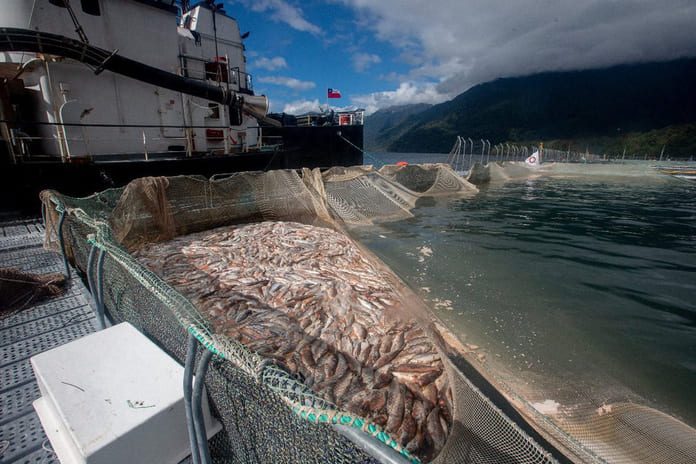Extraordinary mortality causes fewer fish to feed and harvest later this year.
The loss figures from the toxic algae bloom in Chile are rising. The country’s fisheries authority Sernapesca confirmed on Tuesday that 5,595 tonnes of salmon have been lost.
Given an average weight of two kilograms, this involves just under 2.8 million fish. This fish was scheduled to be fed up to five kilos on average. That means close to 14,000 tonnes of salmon in lost sales volume.
Moving fish
According to Sernapesca, 95 per-cent of the dead fish have now been removed and sent to processing facilities, including for fish meal production.
To reduce losses, Sernapesca has given salmon farmers the green light to move 5.9 million live fish from the algae-prone areas of southern Chile.
Anoche y hasta esta madrugada fiscalizamos junto a #AutoridadMaritima descarga de mortalidad de salmones desde PAM Duqueco en Talcahuano. Descargó 670 toneladas que Landes procesará como harina de pescado. pic.twitter.com/LkpvszfSRl
— Servicio Nacional de Pesca y Acuicultura 🇨🇱 (@sernapesca) April 12, 2021
Decline
Chile is the world’s second-largest salmon farmer. Analysts were expecting a 2021 harvest volume of 702,000 tonnes of Atlantic salmon in Chile, before the algae shock. This represented a decrease of 93,000 tonnes from 2020.
Much of the 2020 fish ended up in freezing warehouses, as a function of pandemic problems and air freight halts. Now, however, most of the frozen stockpile has been sold.
“We look at 20 per-cent contraction from Chile this autumn. And the cold stores are mostly empty. It has long been difficult to sell frozen fish in Asia, but now it is getting easier,” a trader told SalmonBusiness on Friday.
Balance por contingencia FAN en regiones de Aysen y Los Lagos: Se ha retirado un 95% de la mortalidad, la cual se ha enviado a plantas reductoras.https://t.co/1Ui25PwBmY pic.twitter.com/HfrvI2p6Jk
— Servicio Nacional de Pesca y Acuicultura (@sernapesca) April 12, 2021

